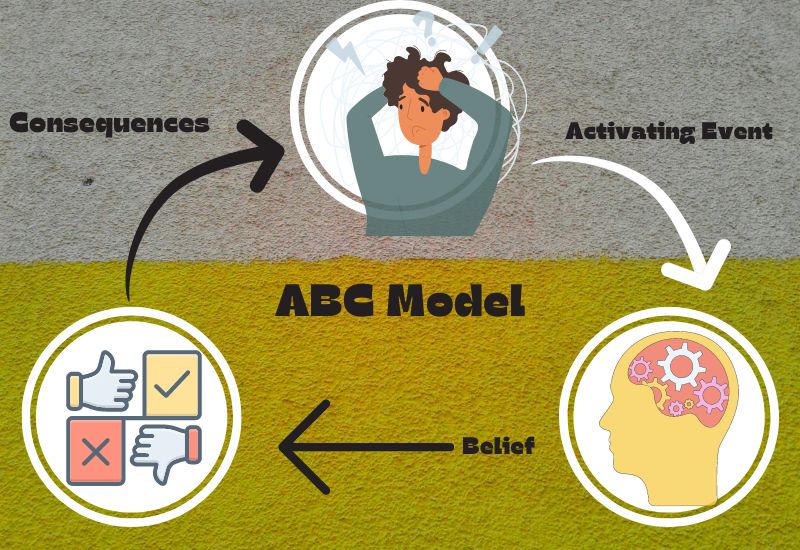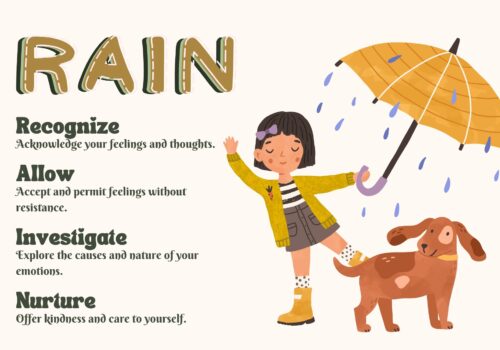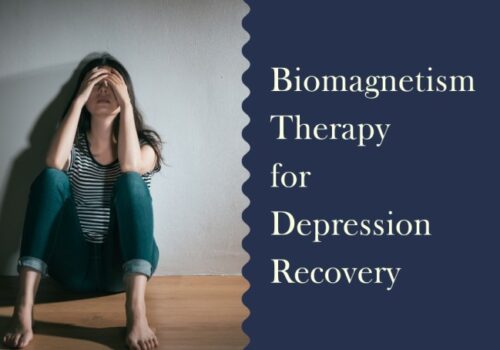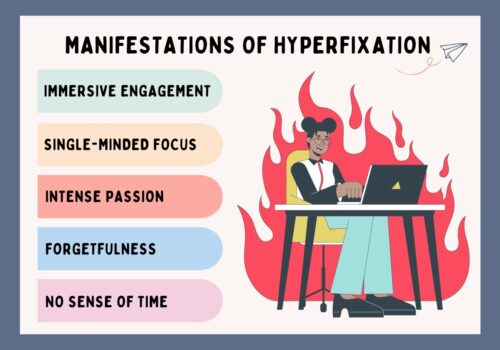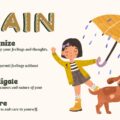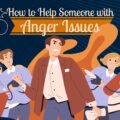The ABC model is a widely accepted approach in CBT or Cognitive Behavioral Therapy that attempts to induce positivity in how people look at events or situations. It helps manage and cure depression in people frequently prone to being negatively impacted by circumstances.
Positive thinking leads to positive behavior, while negative thinking leads to negative behavior. The problem is how we program ourselves to think and act likewise. Constant negative assumptions lead to stress, mental anxiety, and depression. This is where CBT or Cognitive Therapy Behavior uses the ABC model to remedy the thought process and depression.
What is the ABC model in Psychology?
Cognitive Behavioral Therapy (CBT) is a popular approach in psychology that is effective for treating various mental health conditions such as depression, anxiety disorder, mental illness, substance abuse, or even marital problems and eating disorders. The ABC model is a fundamental element of Rational Emotive Behavior Therapy (REBT), a form of CBT whose application is based on the theory that a person’s emotions and behavior are determined by their perception and beliefs in external events.
The ABC model conceived by psychologist and researcher Dr. Albert Ellis can also be defined as a framework that helps affected people understand the relationship between thoughts, emotions, and behaviors. It is a cognitive restructuring that provides insight into the connection between the three key elements of ABC, which are antecedents (A), beliefs (B), and consequences (C). The ABC model, when understood, can do much to improve mental and emotional well-being. It helps affected patients understand their irrational beliefs and the negativity created by them. The ABC model is also a coping mechanism to transform illogical ideas into reasonable ones leading to better decision-making and more positive thinking.
This means a person need not change their environment but adopt a positive mindset to improve things.
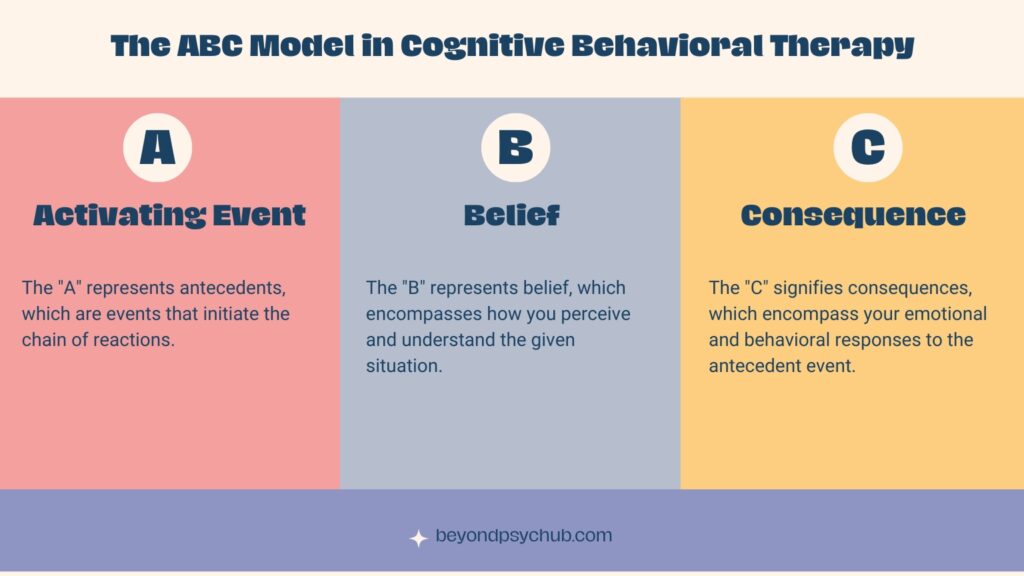
Antecedents or Activating Event
An Antecedent or activating event can be a trigger, an event, or a specific situation that prompts you to react. It could be a range of incidents, such as someone speaking to you rudely, a friend or partner ignoring you, criticism at work, or even a breakup. How you perceive and interpret the event or action will determine your emotional and behavioral reactions. In this scenario, it isn’t the event but how you see it that catalyzes your thought process. It could either affect you temporarily or cause depression for life if perceived with a wrong mindset.
Belief
The B for “Belief” bridges the A and C in the ABC model. It is the point where the action happens and are your thoughts, interpretations, and assumption in response to the Antecedents. According to the ABC-REBT model, beliefs are further separated into irrational and rational beliefs.
Irrational Beliefs
These are beliefs based on cognitive distortions or negative thinking. These rigid, illogical, and extreme mindsets result in negativity, inability to cope, anxiety, depression, and possibly even paranoia. For example, thinking a person rude to you hates you or colleagues at work aren’t cooperating because there is a conspiracy against you.
Irrational beliefs are again divided into two categories.
- Primary beliefs: Demandingness, requiring help or attention. It can also be a situation where one is urged or forced to do something.
- Secondary Beliefs: Awfulizing or assuming the worst in every event, low tolerance in an unpleasant situation, and self-depreciation, where one is always filled with low self-esteem and self-doubt.
Examples of Irrational Beliefs
John was rude to me, so he must hate me
Gina was rude to me this morning because I am an unlikeable person
Rational Beliefs
Rational beliefs are logical beliefs that do not indulge in extreme thinking. Compared to the rigidity of irrational beliefs, rational beliefs are flexible and can also be categorized into primary and secondary beliefs.
- Primary beliefs: These are preferences. A person may believe or feel the urge to do something but choose not to.
- Secondary beliefs: Anti awfulizing, not assuming a negative reason, a high level of frustration tolerance, self-acceptance, and accepting others
Examples of Rational Beliefs
“John was rude to me. He must be having a bad day.”
“Gina was rude to me this morning. Maybe she was in a rush or running late and didn’t have time to chat.”
One must understand that negative emotions are necessary for rational beliefs, such as regret, remorse, annoyance, concern, and sadness. ABC does not aim to do away with some negative emotions entirely but help one with a better coping mechanism to view such beliefs healthily. For example, in the case of grief or mourning, the ABC model cannot be applied literally. It isn’t about turning irrational beliefs into rational ones but normalizing them and helping one cope with them, such as losing a loved one or a child.
Some More Belief Examples:
- Concern (Rational belief): I’m not sure I am prepared for the exam tomorrow, I might get a poor result, but I can handle it.
- Anxiety (irrational belief): I’m not sure I am prepared for tomorrow’s exam; getting a poor result would be a disaster.
Consequences
The C, which stands for consequences, determines your actions due to your beliefs about the activating event. This means how you feel and what you want to do in each situation. Consequences can be positive or negative; it all depends on how you perceive a situation. In the case of interaction, how you interpret someone else’s behavior will determine your own. The consequences may be positive or negative depending on the nature of your beliefs. Negative outcomes may include sorrow, anger, anxiety, avoidance, procrastination, and aggression. On the other hand, positive outcomes include sentiments of happiness, contentment, and healthy coping mechanisms.
Examples
Your siblings or friends ask for help from others instead of you
Irrational belief: They doubt your efficiency, they don’t trust you, or they hate you
Rational belief: They might think you’re busy; they don’t want to disturb you.
The irrational mindset may lead to feelings of hate, depression, anxiety, or sadness. According to a study, irrational beliefs are the primary cause of anger traits than rational beliefs.
The ABCDE Model
A common extension of the ABC model is the ABCDE model, where “D” stands for “disputation of beliefs” and “E” stands for “new effect.” This entails learning to challenge irrational and toxic beliefs when they arise to alter the outcome for the better. For example, a person begins to question his previous negative mindset, which results in new beliefs and constructive thinking. This helps rejuvenate and improve his mental health. He then finds solutions rather than adopting an escapist attitude and depression.
The Benefits of The ABC Model
Research has shown how the ABC model has successfully been used in therapy for anxiety, depression, addiction, anger, phobias, dysfunctional thinking, isolation, and eating disorder.,. Its simplicity allows it to be implemented with basic instruction in the workplace, institutions, and even schools. Besides treating low self-esteem, anxiety, and depression, it has treated anger issues successfully. The ABC model helps people understand their negative triggers and realize that not everything is controllable. Still, they can control their response and actions in a constructive, healthier, and positive manner. The extended benefits are:
- Self-Awareness: The ABC model helps people with insight into their thought patterns and beliefs to form more accurate self-perceptions, leading to better emotional responses.
- Empowerment: It empowers people with more control over their thought processes, emotions, and behavior, which impacts their mental well-being for more positive life changes.
- Improved Coping Strategies: The ABC model helps people cope in challenging situations by transforming irrational beliefs into rational ones. A positive mindset and thought patterns result in better problem-solving, resilience, and coping mechanisms.
How Do Therapists Use the ABC Model?
- In the ABC model, a therapist will follow a sequential line of questioning to assess a patient’s beliefs and reactions to various scenarios.
- Description of scenarios ranging from minor life issues to worst-case conditions
- The patient is asked how they perceive such scenarios and propose to react to them.
- The patient’s beliefs are categorized.
- The therapist then questions the patient to make them aware of their beliefs and the consequences of their responses.
- The therapist then guides the patient on changing their beliefs and mindset and tackling situations with a positive attitude and constructive approach.
Conclusion
The ABC framework is a powerful concept in cognitive behavioral therapy, offering people a way to understand the connection between their thought, emotions, and behavior. Recognizing the key elements that cause people to believe irrationally, individuals can experience a cognitive restructuring to transform their mindset into a more positive one. The ABC model helps people to handle what they might view as the most stressful situations in a positive, rational, and constructive manner. It empowers people with long-lasting coping strategies for a healthier and more emotionally positive life.


